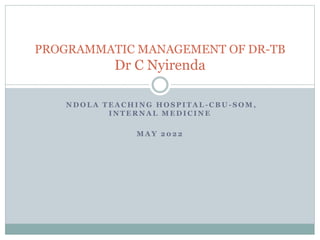MDR-TB 2022_101520.pptx
- 1. N D O L A T E A C H I N G H O S P I T A L - C B U - S O M , I N T E R N A L M E D I C I N E M A Y 2 0 2 2 PROGRAMMATIC MANAGEMENT OF DR-TB Dr C Nyirenda
- 2. Learning objectives ? At the end of this unit the student will be able to: 1. Define MDR-TB 2. List the etiopathogenesis of MDR-TB 3. Understand the epidemiology of MDR-TB 4. Describe the pathophysiology of MDR-TB 5. Identify the clinical manifestations of MDR-TB 6. List the complications of MDR-TB 7. Describe the appropriate investigations for the diagnosis of MDR-TB 8. Basic management of MDR-TB 9. Advise on a follow-up schedule for cases of MDR-TB
- 3. Introduction ? MDR-TB is defined as strains of M. tuberculosis resistant to both isoniazid and rifampicin with or without resistance to other drugs. ? MDR-TB is worrisome because patients that fail treatment have a high risk of death.
- 4. Epidemiology of DR-TB ? MDR-TB is a growing problem in Zambia ? About 1,500 MDR/rifampicin resistant TB (RR-TB) patients among notified PTB patients in Zambia (WHO Global TB Report,2015) ? MDR/RR-TB prevalence among new and previously treated TB patients was 1.1% and 18% respectively
- 5. PMDT ? PMDT structure, a multidisciplinary framework including: ? Clinicians, lab personnel, pharmacists, programme managers, community health workers, monitoring and evaluation managers, supporting partners, procurement and supply chain managers ? Others; regulatory authorities, civil society and DR- TB patients
- 6. PMDT history in Zambia ? Initially one site, the UTH in Lusaka followed by the NTH ? The two sites are now referral centres catering for the southern and northern zones respectively ? Services now decentralized to include provincial hospitals
- 7. DOTS ? Remains at the heart of the Stop TB Strategy The basic components include: ? Political commitment with increased and sustained financing ? Case detection through quality assured bacteriology ? Standardized tx with supervision and patient support ? An effective drug supply and mx system ? Monitoring and Evaluation system and impact measurement
- 8. Directly Observed Therapy ? Ensure cure for the patient ? Ensure adherence to the treatment ? Patient required to take every dose of the recommended treatment regimen ? In DOT supervisor watches the patient swallowing his tablets, thereby ascertaining adherence to treatment
- 9. Isoniazid, rifampicin ? Isoniazid is the most powerful mycobactericidal drug available. ? Ensures early sputum conversion and helps in decreasing transmission of TB. ? Rifampicin, by its mycobactericidal and sterilising activities is crucial for preventing relapses.
- 10. Defn cont ? Thus these two drugs are keystone drugs in the management of TB. ? Resistance to either isoniazid or rifampicin can be managed with other 1st line drugs. ? Resistance to both demands treatment with 2nd line drugs.
- 11. MDR - TB Acquired resistance ? A form of MDR-TB caused by previous incomplete or inadequate treatment Primary resistance ? Acquiring a strain of TB that has already acquired resistance
- 12. RESISTANCE IN CLINICAL PRACTICE ? Causes include; ?Poor compliance ?Physician error ?Lack of drugs ?Malabsorption ?Failure of TB control program ?Lack of lab diagnostic facilities
- 13. Case Finding ? All newly diagnosed re-treatment patients ? TB patients who remain sputum smear-positive after 2months ? Symptomatic close contact of confirmed DR-TB patients ? Symptomatic individuals from high risk groups e.g. health care workers, lab staff, prisoners
- 14. DIAGNOSIS Labs ? DST: most reliable for R and H, less for km and Fq ? GXP positive R resistant-will be referred to start MDR-TB treatment but await confirmation ? LPA is a confirmatory diagnosis ? Res to R and H, followed by DST for Fq and Injectable Additional work-ups ? CXR ? CT scan
- 15. MANAGEMENT cont.. ? Treatment for MDR-TB should never be given on an intermittent basis. ? The average recommended duration is two years for the long term regimen. ? The duration for the short term regimen is 11 months ? 2nd line are generally considered to be less effective than the 1st line drugs and show a greater frequency of adverse reactions. ? Less well tolerated.
- 16. Management cont. ? Use at least 4 effective drugs, never used b4 or susceptible by DST ? Drug selection-Use Z and evaluate E; both not counted among the effective ? One newer generation Fq (mfx or high dose lfx-in adults ? One injectable ( Am )
- 18. Long treatment regimen STANDARDIZED LONGER TREATMENT REGIMEN (FULLY ALL ORAL OPTIONS)
- 19. Short term regimen ? 4-6 Amikacin, Moxifloxacin, Clofazimine, Ethionamide, Pyrazinamide, Ethambutol, High Dose Isoniazid/ 5 Moxifloxacin, Clofazimine, Pyrazinamide, Ethambutol (4®C6 Am-Mfx-Cfz-Eto-Z-E-HHD / 5 Mfx-Cfz-E-Z) ? Add vitamin B6
- 20. END°≠ ? Q/Cs??



















